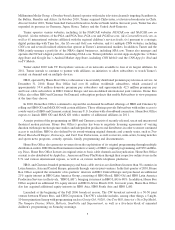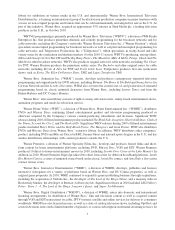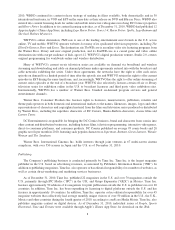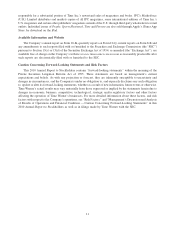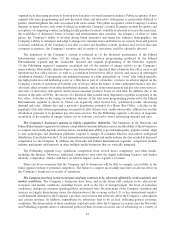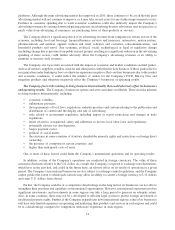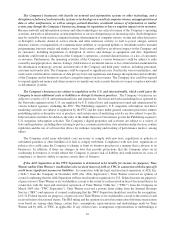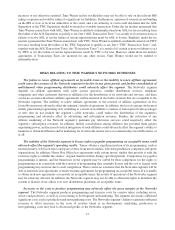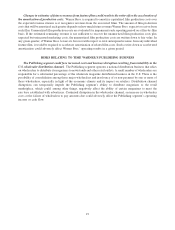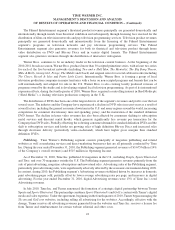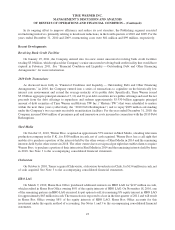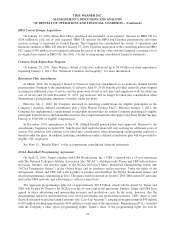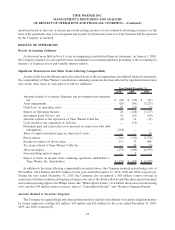Time Magazine 2010 Annual Report Download - page 27
Download and view the complete annual report
Please find page 27 of the 2010 Time Magazine annual report below. You can navigate through the pages in the report by either clicking on the pages listed below, or by using the keyword search tool below to find specific information within the annual report.Piracy of the Company’s content may decrease the revenues received from the exploitation of its content and
adversely affect its businesses and profitability. The piracy of the Company’s content, products and other
intellectual property in the U.S. and internationally poses significant challenges for the Company’s businesses.
Technological advances have made it easier to create, transmit and distribute high quality unauthorized copies of
content in unprotected digital formats. The proliferation of unauthorized copies and piracy of the Company’s
content and products or the products it licenses from third parties could result in a reduction of the revenues that the
Company receives from the legitimate sale and distribution of its content and products. The Company devotes
substantial resources to protecting its intellectual property, but there can be no assurance that the Company’s efforts
to enforce its rights and combat piracy will be successful.
The Company’s businesses may suffer if it cannot continue to license or enforce the intellectual property
rights on which its businesses depend. The Company relies on patent, copyright, trademark and trade secret laws
and licenses and other agreements with its employees, customers, suppliers and other parties to establish and
maintain its intellectual property rights in content, technology and products and services used to conduct its
businesses. However, the Company’s intellectual property rights could be challenged or invalidated, it could have
difficulty obtaining such rights or the rights may not be sufficient to permit it to take advantage of business
opportunities, which could result in costly redesign efforts, discontinuance of certain product and service offerings
or other competitive harm. Further, the laws of certain countries do not protect the Company’s proprietary rights or
such laws may not be strictly enforced, and the Company may be unable to protect its intellectual property
adequately against unauthorized copying or use in certain countries.
The Company has been, and may be in the future, subject to claims of intellectual property infringement,
which could have an adverse impact on the Company’s businesses or operating results. From time to time, the
Company receives notices from others claiming that it infringes their intellectual property rights. Such claims and
lawsuits could require the Company to enter into royalty or licensing agreements on unfavorable terms, incur
substantial monetary liability or be enjoined preliminarily or permanently from further use of the intellectual
property in question. This could require the Company to change its business practices and limit its ability to
compete effectively. If the Company is required to take any of these actions, it could have an adverse impact on the
Company’s businesses or operating results. Even if the Company believes that the claims are without merit,
defending against the claims can be time-consuming and costly and divert management’s attention and resources
away from its businesses.
The Company is exposed to risks associated with disruption in the financial markets. The Company is
exposed to risks associated with disruptions in the financial markets, which can make it more difficult and more
expensive to obtain financing. For example, the adoption of new statutes and regulations, the implementation of
recently enacted laws or new interpretations or the enforcement of older laws and regulations applicable to the
financial markets or the financial services industry could result in a reduction in the amount of available credit or an
increase in the cost of credit. In addition, disruptions in the financial markets can adversely affect the Company’s
lenders, insurers, customers and counterparties, including vendors, retailers and film co-financing partners. For
instance, the inability of the Company’s counterparties to obtain capital on acceptable terms could impair their
ability to perform under their agreements with the Company and lead to various negative effects on the Company,
including business disruption, decreased revenues, increases in bad debt write-offs and, in the case of film co-
financing partners, greater risk with respect to the performance of the Company’s films.
The Company’s businesses are subject to labor interruption. The Company and certain of its suppliers retain
the services of writers, directors, actors, athletes, technicians, trade employees and others involved in the
development and production of motion pictures, television programming and magazines who are covered by
collective bargaining agreements. If the Company or its suppliers are unable to renew expiring collective bargaining
agreements, it is possible that the affected unions could take actions in the form of strikes, work slowdowns or work
stoppages. Such actions or the possibility of such actions, including attempts to unionize, could cause delays in the
production or the release dates of the Company’s feature films, television programming and magazines. The
Company could also incur higher costs from such actions, new collective bargaining agreements or if collective
bargaining agreements are renewed on less favorable terms. In addition, union or labor disputes or player lock-outs
relating to professional sports leagues could have a negative impact on the Networks segment’s subscription and
advertising revenues.
15


